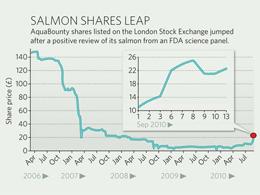Approval expected for genetically modified salmon.

The fish contains a single copy of a DNA sequence that includes code for a Chinook salmon growth hormone and regulatory sequences derived from Chinook salmon and the eel-like ocean pout. Whereas Atlantic salmon normally stop growing in the winter, the GM fish produces growth hormones throughout the year. Developer AquaBounty Technologies, based in Waltham, Massachusetts, has spent more than a decade shepherding the fish towards approval in a new regulatory landscape. In 2009, the FDA decided to classify GM traits in animals as veterinary drugs. Some have criticized this decision, as it allows companies to shield some details of their product from public view as proprietary information (see Nature doi:10.1038/news.2008.1120; 2010).
 Click for larger version.Google Finance
Click for larger version.Google FinanceTo appease critics, the FDA has posted all the information behind its decision on the salmon online, and has opened much of the deliberations of an advisory body — the Veterinary Medicine Advisory Committee (VMAC) — to the public. Next week the VMAC will hold public sessions to hear about the science, safety, environmental impact and possible labelling of the fish. The FDA's Center for Veterinary Medicine, which will decide on approval after hearing from the VMAC, has already released a favourable report.
Some environmental groups are concerned that the fish might escape from their pens and mate with wild Atlantic salmon. "There is always going to be a possibility of escape," says Peter Bridson, aquaculture research manager at the Monterey Bay Aquarium in California. "We would oppose the approval of the current application."
“They are willing to incur huge risks to gain access to food.”
According to Mark Abrahams, a biologist at Memorial University in St John's, Newfoundland, Canada, the transgenic fish's ramped-up metabolism is maladapted to life in the wild. "They are willing to incur huge risks to gain access to food," he says, allowing predators to pick off the fish easily.
ADVERTISEMENT
The next GM animal on dinner plates may be the Enviropig, developed at the University of Guelph, Ontario, Canada, and submitted to the FDA for approval. The pig can better absorb phosphorus from its food, reducing the phosphorus content of its manure. High-phosphorus manure can induce algal blooms in waterways.
There are no requests for authorization of transgenic food animals pending in the European Union, and the European Food Safety Authority, based in Parma, Italy, is just beginning to draft regulatory guidelines. For now, AquaBounty plans to market its salmon only in the United States. "Other countries are interested but they are all looking to the United States for the regulatory imprimatur," says Stotish.
Full Article: http://www.nature.com/news/2010/100914/full/467259a.html
No comments:
Post a Comment